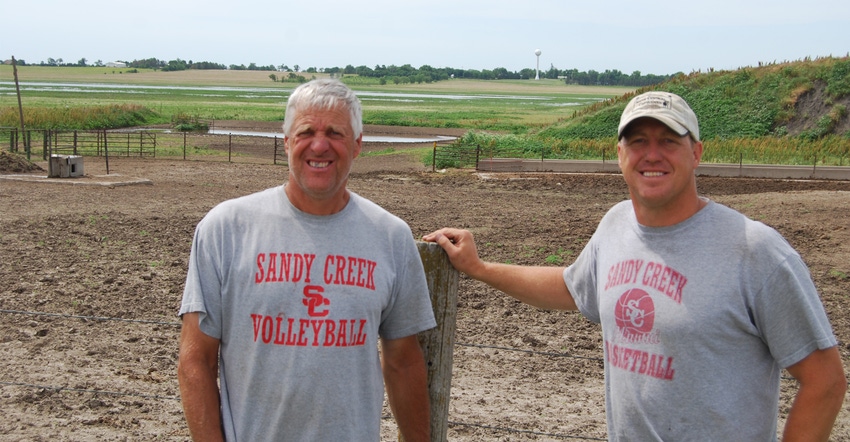
We've written before in Resilient Ag Landscapes columns about grazing annual forage crops and managing grazing on rangeland and pasture. Although rangeland acres are plentiful in the north and west, and in southeast and south-central Nebraska, pasture acres are few and far between. So, some cattle producers have to make the most of the resources they have.
For cattle producers in the Rainwater Basin region — which covers about 4,200 square miles of south-central Nebraska — wetlands can be a viable option for native, warm-season grazing. Since 2002, Steve Shaw and his son Brian have been grazing wetlands on their farm near Edgar, Neb.
These wetlands include a combination of Ducks Unlimited land, Nebraska Game and Parks land, U.S. Fish and Wildlife land, and some privately owned property.
Work with what's available
In 2015, the Shaws were honored with the Nebraska Leopold Conservation Award for their work grazing and preserving wetlands for wildlife habitat.
"In our part of Nebraska, other than small pastures along creeks, you've got to go 50 miles south or 100 miles north to find any sizable acreage to graze," Steve explains. "We've been in the cattle business since the early '70s. When my son came back to the farm in 2002, we were looking at different ways for expansion. That's when the wetland areas became available, and U.S. Fish and Wildlife Service, Nebraska Game and Parks Commission and Ducks Unlimited were changing their management style on those wetlands. The timing was excellent for us."
For the Shaws, wetlands play a critical part in their grazing strategy, which also includes grazing cover crops such as spring wheat and oats in April and May, as well millet, sudangrass, turnips and radishes after they quit grazing wetlands about Sept. 1.
Like many Nebraska cattle producers, their grazing management strategy also includes cornstalks in winter — ideally, from mid- to late September into March, before they start grazing cover crops again.
With the help of wetlands, they are getting closer to grazing year-round — although there are times when it makes sense to feed cattle baled cornstalks supplemented with distillers grains. They also have a quarter of pivot-irrigated wetlands to graze when other forage sources aren't available.
Steps to consider
However, Steve Shaw notes grazing wetlands takes its own strategy.
"Depending on what species of forbs, grass and weeds are in the wetlands, you've got to graze things at the right maturity when they are palatable for cattle," he says. "That was the learning curve for us early on. Things were getting too mature for us, and cattle won't eat an 8-foot-tall sunflower that's bloomed. We had to learn when to graze and learn the different species that cattle like to graze."
This includes less desirable species such as reed canary grass, river bulrush and cattail, all of which must be grazed early, and which U.S. Fish and Wildlife and Nebraska Game and Parks wanted to control — in part, to open up ground for seeds of desirable grasses and forbs.
"Migratory waterfowl can't eat anything from those species," Shaw says. "Those species cut back on production of barnyard grass and quackgrass, the perennial grasses that are desirable for migratory birds. They typically want cattle off by late August or early September, so plants can grow back and produce seeds for migratory birds. Normally, we've planned ahead so some of our other grass or cover crops are available when we quit grazing federal acres."
Many wetland species, including perennials such as western wheatgrass and switchgrass, and annuals like barnyard grass, are more palatable earlier in the grazing season. However, as Shaw notes, every year is different, and sometimes it's necessary to adjust in-season.
"With the flooding last year, most wetlands had 3 to 4 feet of water in them," he says. "This year started out fairly wet, but then we dried out, and the pounds of grass produced in the wetlands was extremely large this year. In average years, we've got to start grazing fairly early, so the growth doesn't get too big on certain plants. If there are water issues, we try to make sure we supplement iodine salt and other minerals so we don't have foot rot problems."
Right cattle, right time
Grazing wetlands sometimes means stocking the right age group of cattle on wetlands at the right time. Since the Shaws began grazing wetlands, they have moved one of their herds to a fall-calving herd. They wean calves off fall-calving cows in April, and put fall-calving cows on wetlands where there isn't much growth, and they'll maintain condition until the grass accumulates more biomass.
However, they can't put bred heifers out in late April or early May. After breeding in late May, they typically put them on wetlands in late June or early July, when grass growth has enough energy to meet their nutritional needs. If there isn't enough rain to meet the needs of heifers or to regrow grass for wildlife in fall, they can put heifers on irrigated grass.
"We've had to put some spring-calving cows on wetlands," Shaw says. "We don't like creep-feeding calves, but we've had to creep-feed some spring calves on wetlands, so the growth rate is adequate. They don't go out and stand in 3 feet of water like some of the mature cows have learned to do. The calf just doesn't have that ability. The cows are going to work from the shallow water to deeper as the season goes along. They learn the system. They teach themselves and learn from each other."
About the Author(s)
You May Also Like






